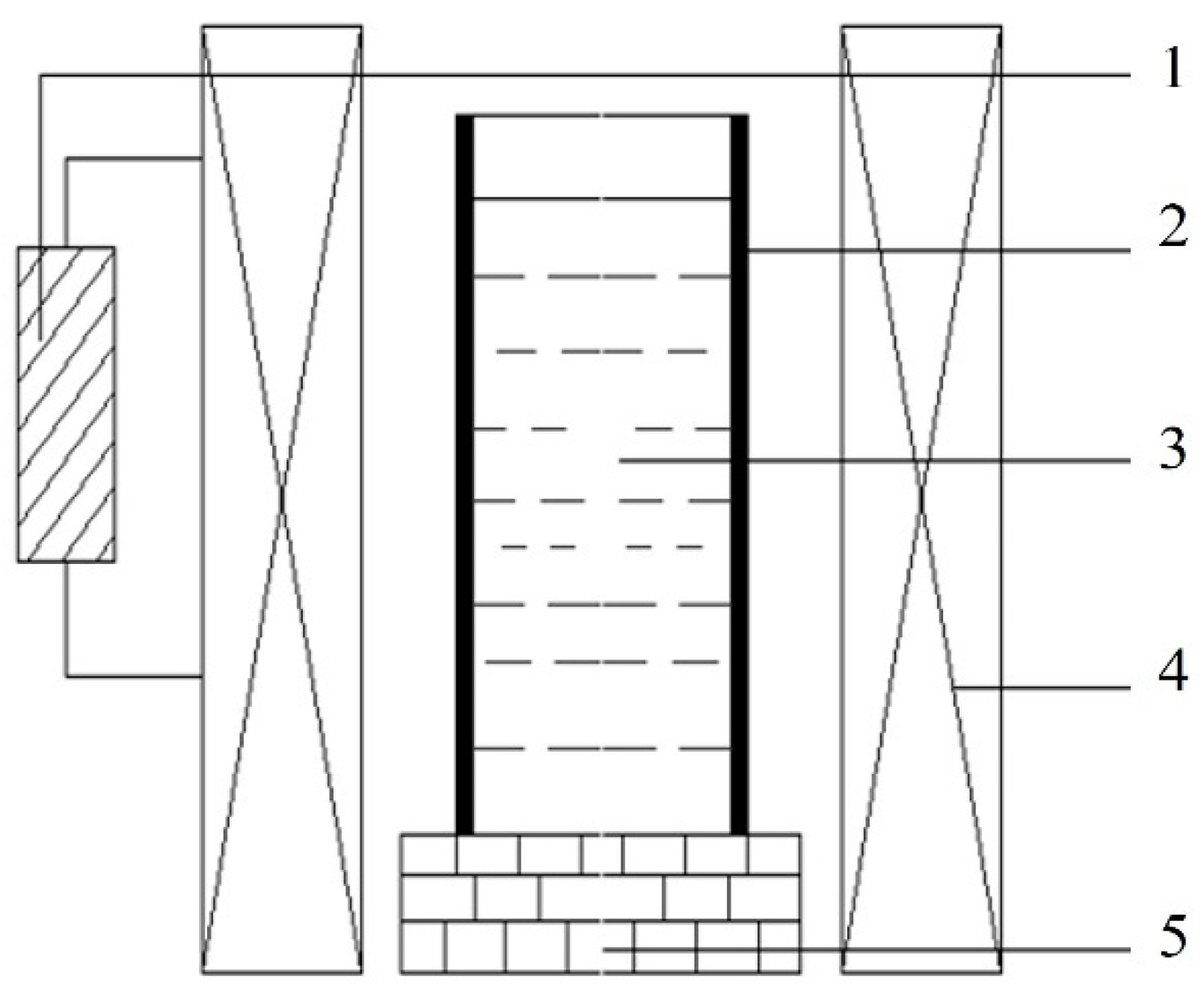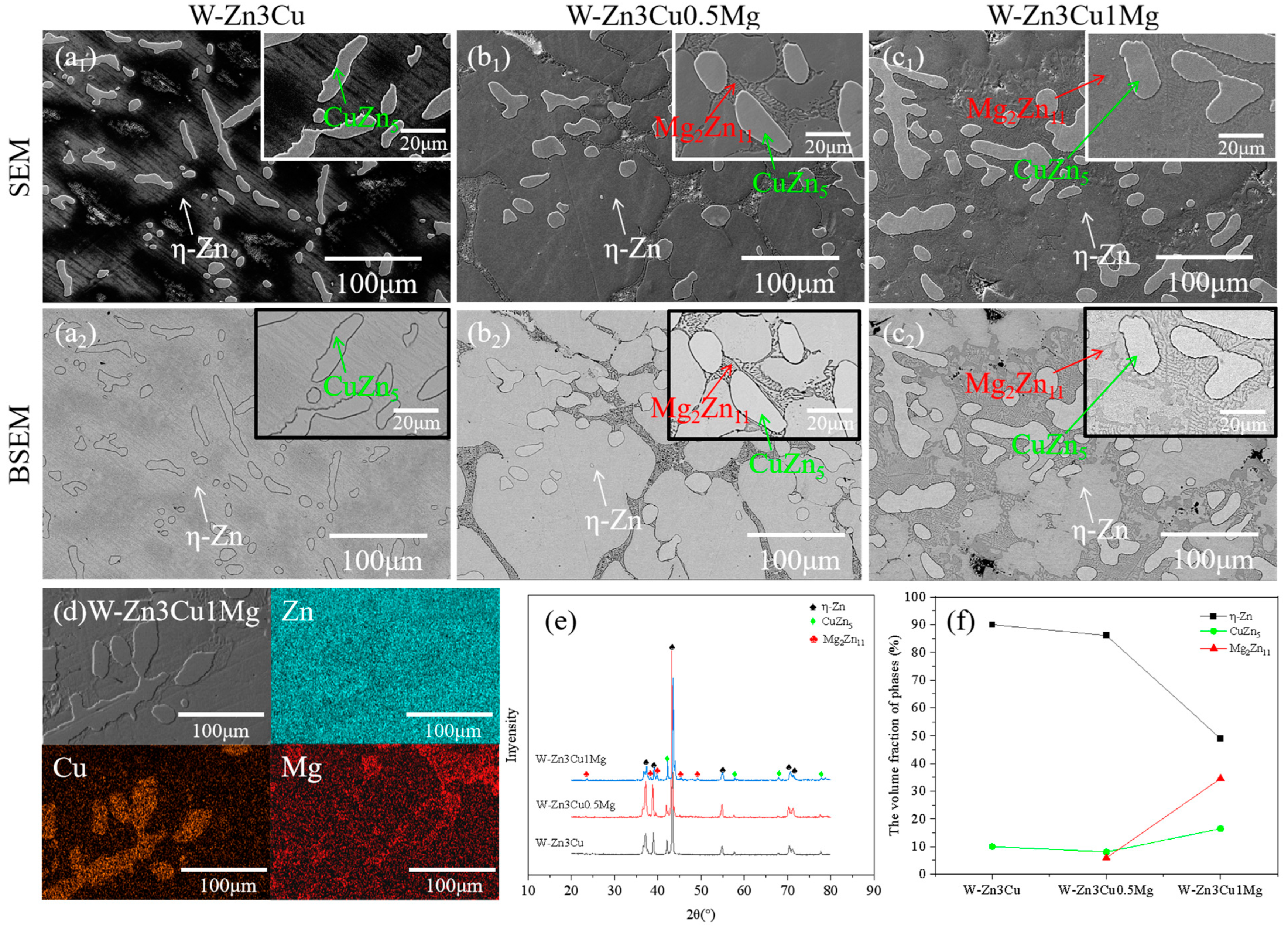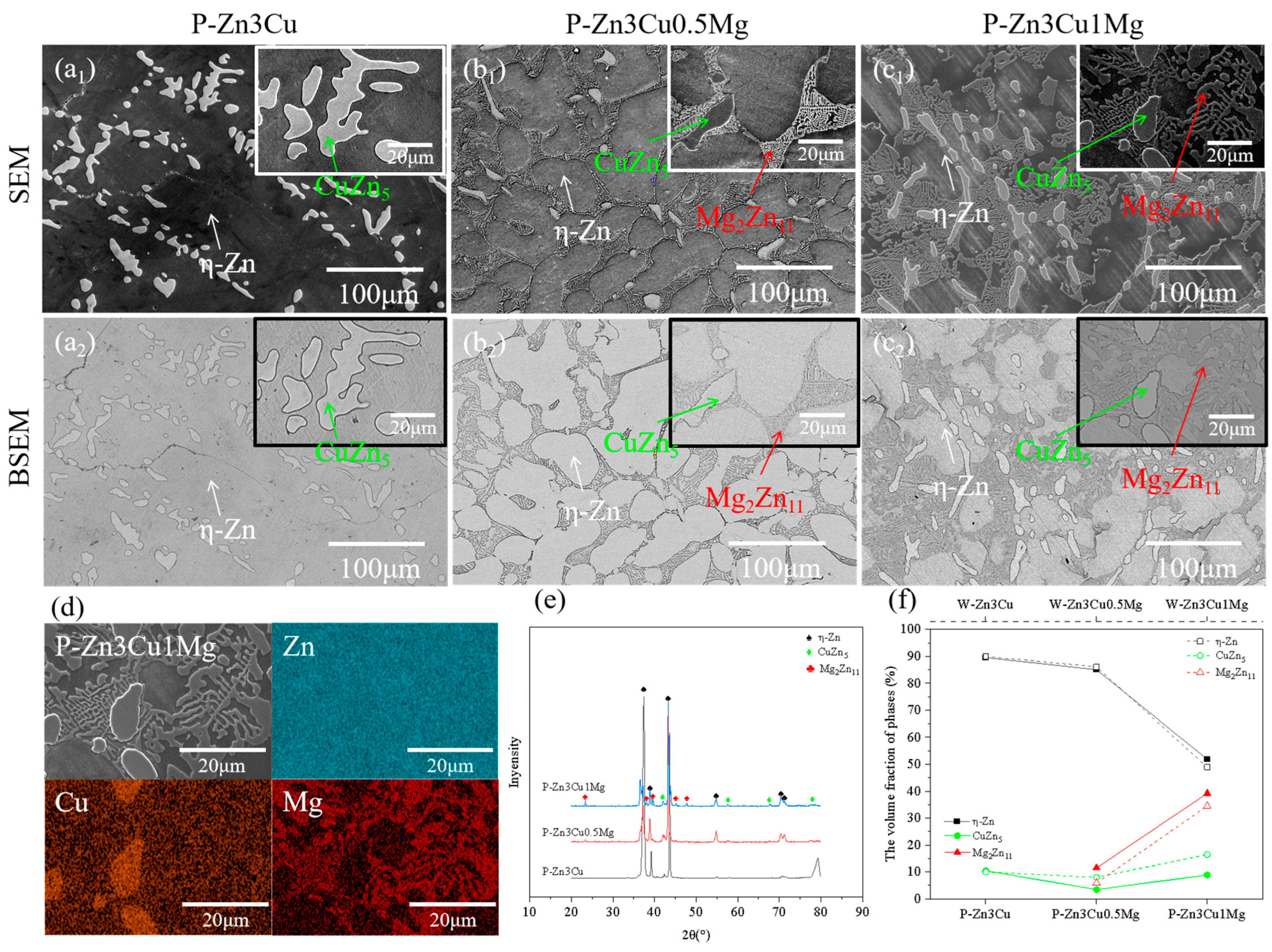Effects of Mg Content and Pulsed Magnetic Field Treatment on Microstructure and Properties of As-Cast Biodegradable Zn-3Cu Alloy
Abstract
1. Introduction
2. Materials and Methods
3. Results and Discussion
3.1. Microstructure
3.2. Mechanical Properties
3.3. Corrosion Properties
3.4. Cytocompatibility and Antibacterial Activity
4. Conclusions
Author Contributions
Funding
Data Availability Statement
Acknowledgments
Conflicts of Interest
References
- Banerjee, P.C.; Al-Saadi, S.; Choudhary, L.; Harandi, S.E.; Singh, R. Magnesium implants: Prospects and challenges. Materials 2019, 12, 136. [Google Scholar] [CrossRef]
- Peuster, M.; Hesse, C.; Schloo, T.; Fink, C.; Beerbaum, P.; von Schnakenburg, C. Long-term biocompatibility of a corrodible peripheral iron stent in the porcine descending aorta. Biomaterials 2006, 27, 4955–4962. [Google Scholar] [CrossRef]
- Mostaed, E.; Sikora-Jasinska, M.; Drelich, J.W.; Vedani, M. Zinc-based alloys for degradable vascular stent applications. Acta Biomater. 2018, 71, 1–23. [Google Scholar] [CrossRef]
- Lin, J.; Tong, X.; Wang, K.; Shi, Z.; Li, Y.; Dargusch, M.; Wen, C. Biodegradable Zn-3Cu and Zn-3Cu-0.2Ti alloys with ultrahigh ductility and antibacterial ability for orthopedic applications. J. Mater. Sci. Technol. 2021, 68, 76–90. [Google Scholar] [CrossRef]
- Lan, C.; Hu, Y.; Wang, C.; Li, W.; Gao, X.; Lin, X. Phase formation and strengthening mechanism of Zn-2 wt%Cu alloy fabricated by laser powder bed fusion. Addit. Manuf. 2024, 85, 104153. [Google Scholar] [CrossRef]
- Tong, X.; Shen, T.; Zhou, X.; Zeng, J.; Tao, J.; Munir, K.; Li, Y.; Huang, S.; Wu, X.; Ma, J.; et al. Biodegradable Zn-Cu-Li alloys with ultrahigh strength, ductility, antibacterial ability, cytocompatibility, and suitable degradation rate for potential bone-implant applications. Smart Mater. Manuf. 2023, 1, 100012. [Google Scholar] [CrossRef]
- Tang, Z.; Niu, J.; Huang, H.; Zhang, H.; Pei, J.; Ou, J.; Yuan, G. Potential biodegradable Zn-Cu binary alloys developed for cardiovascular implant applications. J. Mech. Behav. Biomed. Mater. 2017, 72, 182–191. [Google Scholar] [CrossRef] [PubMed]
- Yang, H.; Jia, B.; Zhang, Z.; Qu, X.; Li, G.; Lin, W.; Zhu, D.; Dai, K.; Zheng, Y. Alloying design of biodegradable zinc as promising bone implants for load-bearing applications. Nat. Commun. 2020, 11, 401. [Google Scholar] [CrossRef] [PubMed]
- Liu, J.; Wang, D.; Liu, B.; Li, N.; Liang, L.; Chen, C.; Zhou, K.; Baker, I.; Wu, H. Microstructural evolution, mechanical properties and corrosion mechanisms of additively manufactured biodegradable Zn-Cu alloys. J. Mater. Sci. Technol. 2024, 186, 142–157. [Google Scholar] [CrossRef]
- Duan, J.; Li, L.; Cao, F.; Suo, Y.; Yang, Q.; Qin, J.; Wang, X.; Yang, Y. An in vitro and in vivo study of biodegradable Zn-Cu-Li alloy with high strength and ductility fabricated by hot extrusion combined with room-temperature ECAP. J. Mater. Res. Technol. 2024, 33, 4226–4242. [Google Scholar] [CrossRef]
- Ye, L.; Huang, H.; Sun, C.; Zhuo, X.; Dong, Q.; Liu, H.; Ju, J.; Xue, F.; Bai, J.; Jiang, J. Effect of grain size and volume fraction of eutectic structure on mechanical properties and corrosion behavior of as-cast Zn-Mg binary alloys. J. Mater. Res. Technol. 2022, 16, 1673–1685. [Google Scholar] [CrossRef]
- García-Mintegui, C.; Córdoba, L.C.; Buxadera-Palomero, J.; Marquina, A.; Jiménez-Piqué, E.; Ginebra, M.-P.; Cortina, J.L.; Pegueroles, M. Zn-Mg and Zn-Cu alloys for stenting applications: From nanoscale mechanical characterization to in vitro degradation and biocompatibility. Bioact. Mater. 2021, 6, 4430–4446. [Google Scholar] [CrossRef] [PubMed]
- Venezuela, J.; Dargusch, M.S. The influence of alloying and fabrication techniques on the mechanical properties, biodegradability and biocompatibility of zinc: A comprehensive review. Acta Biomater. 2019, 87, 1–40. [Google Scholar] [CrossRef]
- Liu, S.; Yao, L.; Wang, Y.; Li, Y.; Jia, Y.; Yang, Y.; Li, N.; Hu, Y.; Kong, D.; Dong, X.; et al. Immunomodulatory hybrid micro-nanofiber scaffolds enhance vascular regeneration. Bioact. Mater. 2019, 21, 464–482. [Google Scholar] [CrossRef] [PubMed]
- Pachla, W.; Przybysz, S.; Jarzębska, A.; Bieda, M.; Sztwiertnia, K.; Kulczyk, M.; Skiba, J. Structural and mechanical aspects of hypoeutectic Zn-Mg binary alloys for biodegradable vascular stent applications. Bioact. Mater. 2021, 6, 26–44. [Google Scholar] [CrossRef]
- Su, L.; Liu, W.; Wang, Y.; Jiang, Y.; Li, Z.; Wang, M.; Liu, G. Corrosion behavior, antibacterial properties and in vitro and in vivo biocompatibility of biodegradable Zn-5Cu-xMg alloy for bone-implant applications. Biomater. Adv. 2024, 165, 214000. [Google Scholar] [CrossRef] [PubMed]
- Jin, H.; Zhao, S.; Guillory, R.; Bowen, P.K.; Yin, Z.; Griebel, A.; Schaffer, J.; Earley, E.J.; Goldman, J.; Drelich, J.W. Novel high-strength, low-alloys Zn-Mg (<0.1wt% Mg) and their arterial biodegradation. Mater. Sci. Eng. C 2018, 84, 67–79. [Google Scholar] [CrossRef]
- Vojtěch, D.; Kubásek, J.; Šerák, J.; Novák, P. Mechanical and corrosion properties of newly developed biodegradable Zn-based alloys for bone fixation. Acta Biomater. 2011, 7, 3515–3522. [Google Scholar] [CrossRef] [PubMed]
- Qin, Y.; Liu, A.; Guo, H.; Shen, Y.; Wen, P.; Lin, H.; Xia, D.; Voshage, M.; Tian, Y.; Zheng, Y. Additive manufacturing of Zn-Mg alloy porous scaffolds with enhanced osseointegration: In vitro and in vivo studies. Acta Biomater. 2022, 145, 403–415. [Google Scholar] [CrossRef] [PubMed]
- Castiglioni, S.; Cazzaniga, A.; Albisetti, W.; Maier, J.A.M. Magnesium and osteoporosis: Current state of knowledge and future research directions. Nutrients 2013, 5, 3022–3033. [Google Scholar] [CrossRef]
- Bordbar-Khiabani, A.; Ebrahimi, S.; Yarmand, B. In-vitro corrosion and bioactivity behavior of tailored calcium phosphate-containing zinc oxide coating prepared by plasma electrolytic oxidation. Corros. Sci. 2020, 173, 108781. [Google Scholar] [CrossRef]
- Shoeib, M.A.; Abdel-Gawad, S.A. High performance nano hydroxyapatite coating on zinc for biomedical applications. J. Mater. Sci. 2023, 58, 740–756. [Google Scholar] [CrossRef]
- Zhang, L.; Hu, P.H.; Zhou, Q.; Zhan, W.; Jin, F. Effects of pulsed magnetic field on microstructure, mechanical properties and bio-corrosion behavior of Mg-7Zn alloy. Mater. Lett. 2017, 193, 224–227. [Google Scholar] [CrossRef]
- Li, L.; Liang, W.; Ban, C.; Suo, Y.; Lv, G.; Liu, T.; Wang, X.; Zhang, H.; Cui, J. Effects of a high-voltage pulsed magnetic field on the solidification structures of biodegradable Zn-Ag alloys. Mater. Charact. 2020, 163, 110274. [Google Scholar] [CrossRef]
- Li, L.; Liang, W.; Yang, L.; Cao, F.; Sun, K.; Ban, C.; Cui, J. Structure Refinement and Homogenization of Zn-Cu Alloys Induced by a High-Voltage Pulsed Magnetic Field During the Solidification Process. Int. J. Met. 2023, 17, 399–413. [Google Scholar] [CrossRef]
- Wang, B.; Yang, Y.-S.; Sun, M.-L. Microstructure refinement of AZ31 alloy solidified with pulsed magnetic field. Trans. Nonferrous Met. Soc. China 2010, 20, 1685–1690. [Google Scholar] [CrossRef]
- Liu, H.; Peng, C.; Yuan, Y.; Zhou, Q.; Chen, L.; Xu, Y. Effect of pulsed magnetic field on solidification microstructure and properties of Zn-3Cu alloy. Trans. Mater. Heat Treat. 2024, 45, 93–101. Available online: https://link.cnki.net/doi/10.13289/j.issn.1009-6264.2023-0275 (accessed on 5 February 2025).
- GB/T 228.1-2021; Metallic Materials—Tensile Testing—Part 1: Method of Test at Room Temperature. Standards Press of China: Beijing, China, 2021.
- Okamoto, H. Comment on Mg-Zn (magnesium-zinc). J. Phase Equilibr. 1994, 15, 129–130. [Google Scholar] [CrossRef]
- Su, Y.; Lin, X.; Wang, M.; Huang, W. Phase and microstructure pattern selection of Zn-rich Zn-Cu peritectic alloys during laser surface remelting. J. Mater. Sci. 2021, 56, 14314–14332. [Google Scholar] [CrossRef]
- Zhang, Y.; Cheng, X.; Zhong, H.; Xu, Z.; Li, L.; Gong, Y.; Miao, X.; Song, C.; Zhai, Q. Comparative Study on the Grain Refinement of Al-Si Alloy Solidified under the Impact of Pulsed Electric Current and Travelling Magnetic Field. Metals 2016, 6, 170. [Google Scholar] [CrossRef]
- Kabir, H.; Munir, K.; Wen, C.; Li, Y. Recent research and progress of biodegradable zinc alloys and composites for biomedical applications: Biomechanical and biocorrosion perspectives. Bioact. Mater. 2021, 6, 836–879. [Google Scholar] [CrossRef]
- ASTM G102-23; Standard Practice for Calculation of Corrosion Rates and Related Informationfrom Electrochemical Measurements. ASTM International: West Conshohocken, PA, USA, 2023.
- Afshari, V.; Dehghanian, C. Effects of grain size on the electrochemical corrosion behaviour of electrodeposited nanocrystalline Fe coatings in alkaline solution. Corros. Sci. 2009, 51, 1844–1849. [Google Scholar] [CrossRef]
- Johnston, S.; Shi, Z.; Atrens, A. The influence of pH on the corrosion rate of high-purity Mg, AZ91 and ZE41 in bicarbonate buffered Hanks’ solution. Corros. Sci. 2015, 101, 182–192. [Google Scholar] [CrossRef]
- Jamesh, M.I.; Wu, G.; Zhao, Y.; McKenzie, D.R.; Bilek, M.M.M.; Chu, P.K. Electrochemical corrosion behavior of biodegradable Mg-Y-RE and Mg-Zn-Zr alloys in Ringer’s solution and simulated body fluid. Corros. Sci. 2015, 91, 160–184. [Google Scholar] [CrossRef]
- Li, H.F.; Xie, X.H.; Zheng, Y.F.; Cong, Y.; Zhou, F.Y.; Qiu, K.J.; Wang, X.; Chen, S.H.; Huang, L.; Tian, L.; et al. Development of biodegradable Zn-1X binary alloys with nutrient alloying elements Mg, Ca and Sr. Sci. Rep. 2015, 5, srep10719. [Google Scholar] [CrossRef]
- Mwaanga, P.; Carraway, E.R.; van den Hurk, P. The induction of biochemical changes in Daphnia magna by CuO and ZnO nanoparticles. Aquat. Toxicol. 2014, 150, 201–209. [Google Scholar] [CrossRef]








| Sample | Rs /Ω·cm2 | CPE1 /μF·cm−2 | n1 | R1 /Ω·cm2 | CPE2 /μF·cm−2 | n2 | R2 /Ω·cm2 | χ2 |
|---|---|---|---|---|---|---|---|---|
| W-Zn3Cu | 11.54 ± 1.25 | 5.02 ± 0.36 | 0.87 ± 0.03 | 1219.00 ± 154.15 | 102.63 ± 12.02 | 0.73 ± 0.03 | 1571.50 ± 405.17 | 3.09 × 10−3 |
| W-Zn3Cu0.5Mg | 11.75 ± 1.21 | 5.25 ± 1.70 | 0.86 ± 0.03 | 1070.47 ± 495.62 | 228.54 ± 102.80 | 0.72 ± 0.05 | 1177.77 ± 539.01 | 1.37 × 10−3 |
| W-Zn3Cu1Mg | 11.64 ± 1.21 | 5.04 ± 1.50 | 0.83 ± 0.02 | 765.05 ± 332.27 | 210.71 ± 60.39 | 0.68 ± 0.02 | 976.00 ± 91.92 | 2.56 × 10−3 |
| P-Zn3Cu | 12.91 ± 1.09 | 122.82 ± 38.31 | 0.75 ± 0.03 | 1524.70 ± 496.79 | 4.73 ± 0.79 | 0.86 ± 0.01 | 1320.70 ± 447.63 | 1.97 × 10−3 |
| P-Zn3Cu0.5Mg | 11.81 ± 0.42 | 4.93 ± 0.75 | 0.79 ± 0.04 | 1326.63 ± 939.22 | 220.10 ± 45.61 | 0.72 ± 0.10 | 1132.57 ± 264.25 | 1.97 × 10−3 |
| P-Zn3Cu1Mg | 10.40 ± 2.64 | 179.28 ± 58.01 | 0.69 ± 0.13 | 1029.63 ± 610.66 | 6.13 ± 0.24 | 0.79 ± 0.14 | 883.73 ± 127.43 | 7.68 × 10−3 |
Disclaimer/Publisher’s Note: The statements, opinions and data contained in all publications are solely those of the individual author(s) and contributor(s) and not of MDPI and/or the editor(s). MDPI and/or the editor(s) disclaim responsibility for any injury to people or property resulting from any ideas, methods, instructions or products referred to in the content. |
© 2025 by the authors. Licensee MDPI, Basel, Switzerland. This article is an open access article distributed under the terms and conditions of the Creative Commons Attribution (CC BY) license (https://creativecommons.org/licenses/by/4.0/).
Share and Cite
Shi, L.; Liu, H.; Liu, H.; Peng, C.; Ren, L. Effects of Mg Content and Pulsed Magnetic Field Treatment on Microstructure and Properties of As-Cast Biodegradable Zn-3Cu Alloy. Metals 2025, 15, 175. https://doi.org/10.3390/met15020175
Shi L, Liu H, Liu H, Peng C, Ren L. Effects of Mg Content and Pulsed Magnetic Field Treatment on Microstructure and Properties of As-Cast Biodegradable Zn-3Cu Alloy. Metals. 2025; 15(2):175. https://doi.org/10.3390/met15020175
Chicago/Turabian StyleShi, Lizhen, Hui Liu, Houqing Liu, Cong Peng, and Ling Ren. 2025. "Effects of Mg Content and Pulsed Magnetic Field Treatment on Microstructure and Properties of As-Cast Biodegradable Zn-3Cu Alloy" Metals 15, no. 2: 175. https://doi.org/10.3390/met15020175
APA StyleShi, L., Liu, H., Liu, H., Peng, C., & Ren, L. (2025). Effects of Mg Content and Pulsed Magnetic Field Treatment on Microstructure and Properties of As-Cast Biodegradable Zn-3Cu Alloy. Metals, 15(2), 175. https://doi.org/10.3390/met15020175






